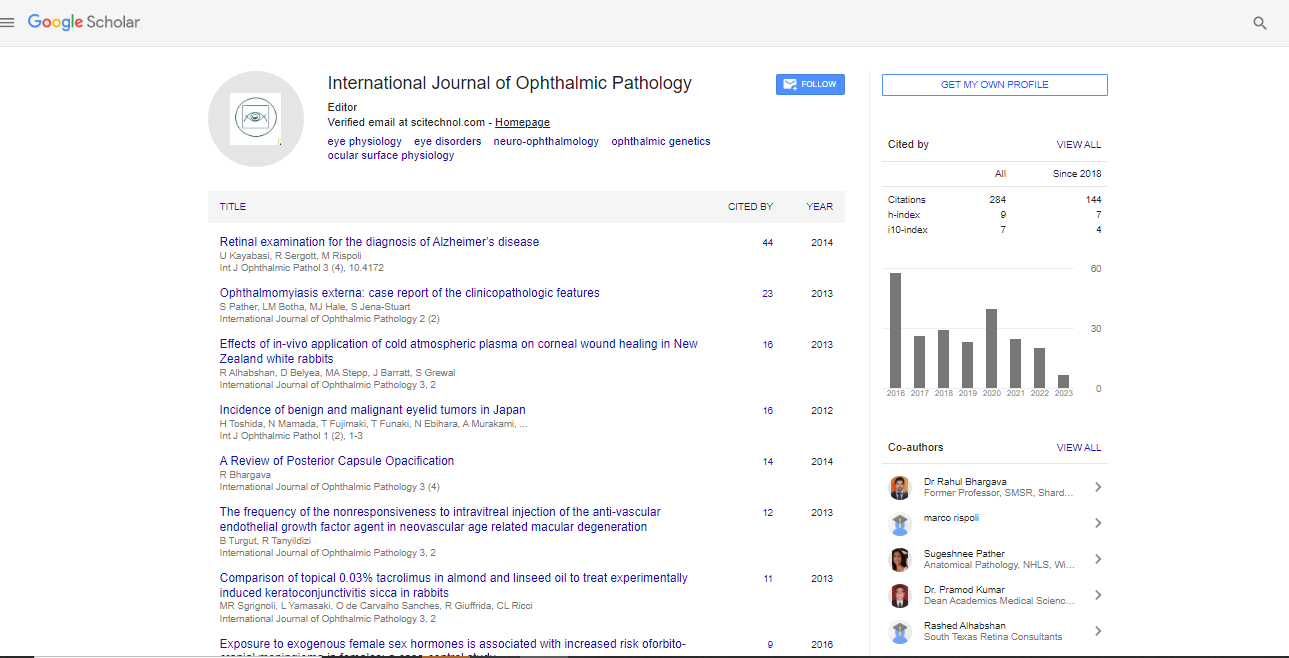Commentary, Int J Ophthalmic Pathol Vol: 0 Issue: 0
Risk Factors and Treatment of Branch Retinal Vein Occlusion
Kira Hudson Banks*
Department of Ophthalmology, St. Louis Collage, USA
*Corresponding Author:
Kira Hudson Banks
Department of Ophthalmology, St. Louis Collage, USA
E-mail: Bankas.k@health.slu.edu
Received: June 02, 2021 Accepted: July 16, 2021 Published: July 23, 2021
Citation: Banks K (2021) Risk Factors and Treatment of Branch Retinal Vein Occlusion. Int J Ophthalmic Pathol 10:7. (290)
Abstract
Retinal vein occlusion (RVO) is the second most common type of retinal vascular disorder, after diabetic retinal disease, and one of the most common causes of the sudden painless unilateral loss of vision .
Keywords: Retinal vein occlusion , Eye Conditions
Introduction
Retinal vein occlusion (RVO) is the second most common type of retinal vascular disorder, after diabetic retinal disease, and one of the most common causes of the sudden painless unilateral loss of vision . RVO can be divided into two main types: branch retinal vein occlusion (BRVO) and central retina vein occlusion (CRVO). Generally, BRVO has a better prognosis than CRVO.
Risk Factors
BRVO has many known ophthalmic and foundational hazard factors thinking about its muddled pathogenesis. It is broadly realized that propelling age is a significant danger factor for BRVO since the primary pathogenic component of BRVO is blood vessel firmness that causes venous pressure in the normal adventitial sheath. Foundational vascular sicknesses like hypertension (HTN), hyperlipidemia (HLD), and fringe blood vessel illness (PAD) and metabolic infections like diabetes mellitus (DM) are totally associated with BRVO. Be that as it may, the presence of dyslipidemia really lessened a portion of the expanded danger of BRVO among people who had different segments of the metabolic disorder. Additionally Lam et al. detailed that hazard factors for creating BRVO more youthful than 50 years were basically the same as those in more established individuals in this manner, these two articles together can make an entire story. It isn't totally clear which job thrombophilia plays in the BRVO pathogenesis. Blood anomalies assume a questionable part in the pathogenesis of BRVO, and erythrocyte volume, level of fibrinogen, and hematocrits seem, by all accounts, to be significant. Extra examinations additionally detailed other more uncommon danger factors like obstructive rest apnea (OSA), incidental retrobulbar needle hole, pivotal length and glassy chamber profundity, liver or renal infections, and surprisingly back glassy grip.
Treatment
The treatment of BRVO is involved three principle stages: distinguishing proof and treatment of modifiable danger factors, explicit treatment of the vascular impediment, and treatment of BRVO difficulties, for example, macular edema, retinal neovascularization, glassy discharge, and footing retinal separation to work on visual sharpness and metamorphopsia. The primary reason for all medicines is the goal of the macular edema before the foveal photoreceptor layer is harmed. The administration of macular edema optional to branch retinal vein impediment has incredibly worked on as of late with the presentation of a treatment dependent on intravitreal infusion of antivascular endothelial development factor atoms and steroids.
Patient results even with indistinguishable medicines can be endlessly unique because of infection, and patient heterogeneity prognostic variables for BRVO incorporate patient age , pattern visual keenness and retinal thickness , early reaction to treatment , span of macular edema , back glassy separation , OCT trademark , cytokine level , focal retinal affectability , spilling vessels and microaneurysms in the perifoveal hairlike organization , retinal color epithelium (RPE) honesty genuine retinal separation , and subretinal drain . A portion of these prognostic elements are as yet questionable. Essentially, patients with a more youthful age, milder side effect more limited span of CME, and better reaction to early treatment will in general have a superior result. A new study detailed that retina experts getting CME optional RVO suggest various medicines for patients than they would decide for themselves. This proposes that psychological predispositions exist and one should think about this when making treatment suggestions for their patients.
Conclusion
Branch retinal vein impediment is an exceptionally normal retinal sickness. The most regularly utilized medicines as of now are against VEGF medications and corticosteroids, since they achieve critical improvement in VA and CMT with generally less entanglements. Regardless of whether one treatment isn't viable specifically patients, there are various medicines and mix treatments that can be thought of. Novel medicines have changed our consideration of patients with retinal vein impediments. Further investigations into the pathophysiology, hazard elements, and treatment of retinal vein impediments stay continuous, and we keep on working on our treatment of patients with this troublesome infection through customized medication and improvement of new techniques and medicines.
References
- Cugati S, Wang JJ, Rochtchina E, Mitchell P (2006) “Ten-year incidence of retinal vein occlusion in an older population: the blue moun tains eye study,” Archives of Ophthalmology, 124: 726–732.
- Rogers S, McIntosh RL, Cheung N (2010) “The prevalence of retinal vein occlusion: pooled data from population studies from the United States, Europe, Asia, and Australia,” Ophthalmology, 117:313–319.
- Rogers SL, McIntosh RL, Lim L “Natural history of branch retinal vein occlusion: an evidence-based systematic review,” Ophthalmology, 117: 1094–1101.
 Spanish
Spanish  Chinese
Chinese  Russian
Russian  German
German  French
French  Japanese
Japanese  Portuguese
Portuguese  Hindi
Hindi 